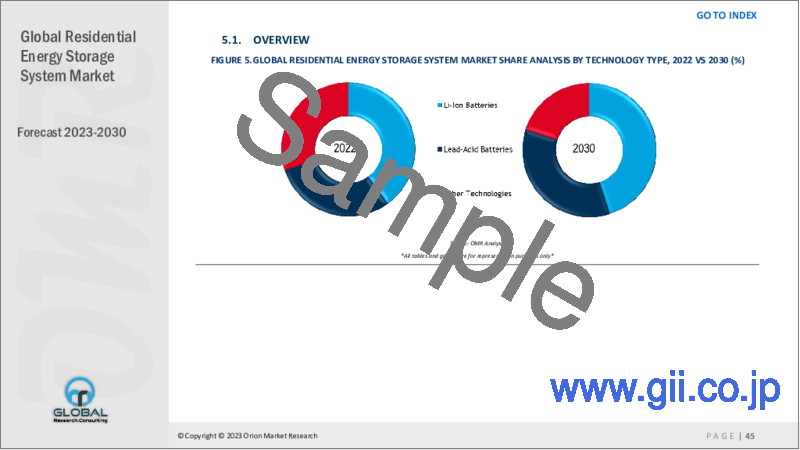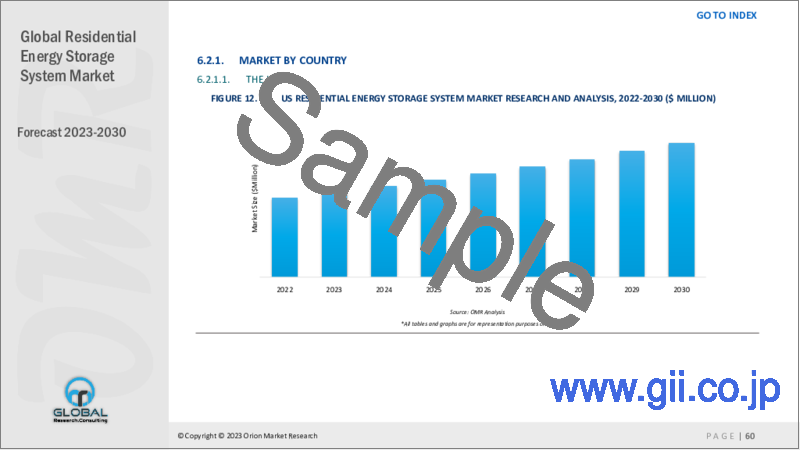|
|
市場調査レポート
商品コード
1327639
住宅用蓄電システム(ESS)の世界市場:2023-2030年Global Residential Energy Storage System (ESS) Market 2023-2030 |
||||||
カスタマイズ可能
|
|||||||
| 住宅用蓄電システム(ESS)の世界市場:2023-2030年 |
|
出版日: 2023年07月12日
発行: Orion Market Research
ページ情報: 英文 133 Pages
納期: 2~3営業日
|
- 全表示
- 概要
- 図表
- 目次
世界の住宅用エネルギー貯蔵システム(ESS)市場は、予測期間中にCAGR 23.8%の飛躍的な成長が見込まれています。中央集権的でなく、デジタル化された持続可能なエネルギーシステムを促進する政府の政策が、世界の住宅用ESS市場の成長を促進する上で重要な役割を果たしています。この成長に大きく貢献しているのが、ストレージと組み合わせたソーラー義務化の実施です。例えば、2020年初頭に施行されたカリフォルニア州の太陽光発電義務化です。これは、すべての住宅(3階建てまで)に、家庭の年間エネルギー需要を平均して相殺できるだけの太陽光発電(PV)システムを組み込むことを義務付けるものです。
この政策の下で、住宅所有者は、義務付けられたPVの「クレジット」を「蓄電」クレジットと交換する機会があり、蓄電ソリューションの採用をさらに奨励します。さらに、総合的な建物の改築と効率基準が市場拡大の要因となっています。例えば、イタリアは改修刺激策と、年間税額からPVと蓄電コストの110.0%を控除するオプションを組み合わせています。住宅用蓄電池分野は、ソーラーパワー欧州が初めて発表した「住宅用蓄電池に関する欧州市場見通し2020-2024」に示されるように、高い将来性を持って著しい成長を遂げています。同市場の年間成長率は57.0%と目覚ましく、昨年は96,000システム、合計745MWhが設置されました。
蓄電設備に対する税制上の償却は、世界の住宅用ESS市場の成長に有利な機会を提供すると予想されます。例えばイタリアでは、年間課税額から基準額の50.0%(i.e. 4,000ユーロ)を控除するオプションがあり、蓄電ソリューションへの投資をさらに促進しています。オランダでは、投資額を3年間にわたって減価償却することが認められています。全体として、こうした支援政策や優遇措置が世界の住宅用ESS市場の拡大を後押ししており、かなりの成長ポテンシャルを秘めた有望な分野となっています。
セグメント別の展望
地域別展望
住宅用ESSの世界市場は、北米(米国とカナダ)、欧州(イタリア、スペイン、ドイツ、フランス、その他)、アジア太平洋(インド、中国、日本、韓国、その他)、世界のその他の地域(中東とアフリカ、ラテンアメリカ)など、地域別にさらに細分化されています。なかでも欧州は、予測期間中にかなりのCAGRで成長すると推定されます。欧州の多くの国では、家庭用蓄電池が非常に普及しています。主要市場では、住宅用ソーラーシステムへのストレージの取り付け率は90%を超えています。
これにはいくつかの動機があるが、それらはすべて、感情と経済性という2つの主要な原動力にまとめることができます。2023年6月、カナディアン・ソーラーはIntersolar Europe 2023で、エターナル・プラネットが自社設計・開発した初の住宅用蓄電システムEP Cubeを発表し、欧州市場における新たなマイルストーンとなります。EP Cubeは停電時の電力供給を自動化し、送電網がダウンしても高出力の電化製品が正常に動作するようにすることができます。EP Cubeがあれば、住宅所有者は電力供給不足や不安定さを心配する必要がなくなります。こうした発展は、この地域の市場成長にさらに貢献しています。
アジア太平洋地域は世界の住宅用ESS市場でかなりのシェアを占めると予測される
アジア太平洋地域は、中国、インド、日本などの国々における再生可能エネルギー部門の成長によって、世界の住宅用ESS市場でかなりの市場シェアを占めると予想されます。中でも中国とインドは、ソーラーパネル産業において際立っています。特に中国は、太陽光発電設備と太陽光発電パネル生産の両面で大きな可能性を秘めています。国際エネルギー機関(IEA)によると、中国は最大の太陽光発電設置容量を誇り、2019年には205GWを超え、世界の設置量の35.0%以上を占めました。さらに、中国は世界最大の太陽光発電機器メーカーとしてリードしています。同国におけるソーラーパネルの普及は、住宅用ESSの需要に大きく寄与しています。これらの機器により、消費者は太陽が出ていない時間帯でも太陽光発電を利用できるようになり、必要なときに自家発電したクリーンな電力をより多く利用できるようになります。したがって、この地域全体でソーラーパネルが大規模に採用されていることが、この地域の市場を牽引する重要な要因となっています。
目次
第1章 レポート概要
- 業界の現状分析と成長ポテンシャルの展望
- 調査方法とツール
- 市場内訳
- セグメント別
- 地域別
第2章 市場概要と洞察
- 調査範囲
- アナリストの洞察と現在の市場動向
- 主な調査結果
- 推奨事項
- 結論
第3章 競合情勢
- 主要企業分析
- Panasonic Holdings Corp.
- 概要
- 財務分析
- SWOT分析
- 最近の動向
- Sonnen GmbH
- 会社概要
- 財務分析
- SWOT分析
- 最近の動向
- Tesla Inc.
- 概要
- 財務分析
- SWOT分析
- 最近の動向
- VARTA AG
- 概要
- 財務分析
- SWOT分析
- 最近の動向
- 主要戦略分析
第4章 市場セグメンテーション
- 住宅用蓄電システム(ESS)の世界市場:技術タイプ別
- リチウムイオン電池
- 鉛蓄電池
- その他の技術
第5章 地域別分析
- 北米
- 米国
- カナダ
- 欧州
- 英国
- ドイツ
- イタリア
- スペイン
- フランス
- その他欧州
- アジア太平洋
- 中国
- インド
- 日本
- 韓国
- その他アジア太平洋地域
- 世界のその他の地域
第6章 企業プロファイル
- ABB Ltd.
- BYD Company
- Deutsche Energieversorgung GmbH(SENEC)
- Eaton Corp.
- Eguana technologies, Inc.
- Enphase Energy, Inc.
- Hitachi energy Ltd.
- Huawei Technologies, Co. Ltd.
- LG Energy Solution Ltd.
- Panasonic Corp.
- Saft Groupe SA
- Samsung SDI Co. Ltd.
- Siemens AG
- Sonnen GmbH
- Sunverge Energy LLC
- Tesla Inc.
- VARTA AG
LIST OF TABLES
- 1. GLOBAL RESIDENTIAL ENERGY STORAGE SYSTEM (ESS) MARKET RESEARCH AND ANALYSIS BY TECHNOLOGY TYPE,2022-2030 ($ MILLION)
- 2. GLOBAL LI-ION BATTERIES BASED RESIDENTIAL ENERGY STORAGE SYSTEM (ESS) MARKET RESEARCH AND ANALYSIS BY REGION, 2022-2030 ($ MILLION)
- 3. GLOBA LEAD-ACID BATTERIES BASED RESIDENTIAL ENERGY STORAGE SYSTEM (ESS) MARKET RESEARCH AND ANALYSIS BY REGION, 2022-2030 ($ MILLION)
- 4. GLOBAL OTHER TECHNOLOGIES BASED RESIDENTIAL ENERGY STORAGE SYSTEM (ESS) MARKET RESEARCH AND ANALYSIS BY REGION, 2022-2030 ($ MILLION)
- 5. GLOBAL RESIDENTIAL ENERGY STORAGE SYSTEM (ESS) MARKET RESEARCH AND ANALYSIS BY REGION, 2022-2030 ($ MILLION)
- 6. NORTH AMERICAN RESIDENTIAL ENERGY STORAGE SYSTEM (ESS) MARKET RESEARCH AND ANALYSIS BY COUNTRY, 2022-2030 ($ MILLION)
- 7. NORTH AMERICAN RESIDENTIAL ENERGY STORAGE SYSTEM (ESS) MARKET RESEARCH AND ANALYSIS BY TECHNOLOGY TYPE, 2022-2030 ($ MILLION)
- 8. EUROPEAN RESIDENTIAL ENERGY STORAGE SYSTEM (ESS) MARKET RESEARCH AND ANALYSIS BY COUNTRY, 2022-2030 ($ MILLION)
- 9. EUROPEAN RESIDENTIAL ENERGY STORAGE SYSTEM (ESS) MARKET RESEARCH AND ANALYSIS BY TECHNOLOGY TYPE, 2022-2030 ($ MILLION)
- 10. ASIA-PACIFIC RESIDENTIAL ENERGY STORAGE SYSTEM (ESS) MARKET RESEARCH AND ANALYSIS BY COUNTRY, 2022-2030 ($ MILLION)
- 11. ASIA-PACIFIC RESIDENTIAL ENERGY STORAGE SYSTEM (ESS) MARKET RESEARCH AND ANALYSIS BY TECHNOLOGY TYPE, 2022-2030 ($ MILLION)
- 12. REST OF THE WORLD RESIDENTIAL ENERGY STORAGE SYSTEM (ESS) MARKET RESEARCH AND ANALYSIS BY COUNTRY, 2022-2030 ($ MILLION)
- 13. REST OF THE WORLD RESIDENTIAL ENERGY STORAGE SYSTEM (ESS) MARKET RESEARCH AND ANALYSIS BY TECHNOLOGY TYPE, 2022-2030 ($ MILLION)
LIST OF FIGURES
- 1. GLOBAL RESIDENTIAL ENERGY STORAGE SYSTEM (ESS) MARKET SHARE BY TECHNOLOGY TYPE, 2022 VS 2030 (%)
- 2. GLOBAL LI-ION BATTERIES BASED RESIDENTIAL ENERGY STORAGE SYSTEM (ESS) MARKET SHARE BY REGION, 2022 VS 2030 (%)
- 3. GLOBAL LEAD-ACID BATTERIES BASED RESIDENTIAL ENERGY STORAGE SYSTEM (ESS) MARKET SHARE BY REGION, 2022 VS 2030 (%)
- 4. GLOBAL OTHER TECHNOLOGIES BASED RESIDENTIAL ENERGY STORAGE SYSTEM (ESS) MARKET SHARE BY REGION, 2022 VS 2030 (%)
- 5. GLOBAL RESIDENTIAL ENERGY STORAGE SYSTEM (ESS) MARKET SHARE BY REGION, 2022 VS 2030 (%)
- 6. US RESIDENTIAL ENERGY STORAGE SYSTEM (ESS) MARKET SIZE, 2022-2030 ($ MILLION)
- 7. CANADA RESIDENTIAL ENERGY STORAGE SYSTEM (ESS) MARKET SIZE, 2022-2030 ($ MILLION)
- 8. UK RESIDENTIAL ENERGY STORAGE SYSTEM (ESS) MARKET SIZE, 2022-2030 ($ MILLION)
- 9. FRANCE RESIDENTIAL ENERGY STORAGE SYSTEM (ESS) MARKET SIZE, 2022-2030 ($ MILLION)
- 10. GERMANY RESIDENTIAL ENERGY STORAGE SYSTEM (ESS) MARKET SIZE, 2022-2030 ($ MILLION)
- 11. ITALY RESIDENTIAL ENERGY STORAGE SYSTEM (ESS) MARKET SIZE, 2022-2030 ($ MILLION)
- 12. SPAIN RESIDENTIAL ENERGY STORAGE SYSTEM (ESS) MARKET SIZE, 2022-2030 ($ MILLION)
- 13. REST OF EUROPE RESIDENTIAL ENERGY STORAGE SYSTEM (ESS) MARKET SIZE, 2022-2030 ($ MILLION)
- 14. INDIA RESIDENTIAL ENERGY STORAGE SYSTEM (ESS) MARKET SIZE, 2022-2030 ($ MILLION)
- 15. CHINA RESIDENTIAL ENERGY STORAGE SYSTEM (ESS) MARKET SIZE, 2022-2030 ($ MILLION)
- 16. JAPAN RESIDENTIAL ENERGY STORAGE SYSTEM (ESS) MARKET SIZE, 2022-2030 ($ MILLION)
- 17. SOUTH KOREA RESIDENTIAL ENERGY STORAGE SYSTEM (ESS) MARKET SIZE, 2022-2030 ($ MILLION)
- 18. REST OF ASIA-PACIFIC RESIDENTIAL ENERGY STORAGE SYSTEM (ESS) MARKET SIZE, 2022-2030 ($ MILLION)
- 19. REST OF THE WORLD RESIDENTIAL ENERGY STORAGE SYSTEM (ESS) MARKET SIZE, 2022-2030 ($ MILLION)
Title: Global Residential Energy Storage System (ESS) Market Size, Share & Trends Analysis Report by Technology Type (Li-Ion Batteries, Lead-Acid Batteries, and Other Technologies)Forecast Period (2023-2030).
The global residential energy storage system (ESS) market is anticipated to grow at an exponential CAGR of 23.8% during the forecast period. Cohesive government policies that promote less centralized, more digitalized, and sustainable energy system plays a crucial role in driving the growth of the global residential ESS market. One significant contributor to this growth is the implementation of Solar Mandates coupled with storage. For instance, California's solar mandate, which took effect in early 2020. It requires all residential buildings (up to three stories) to incorporate enough Photovoltaic (PV) systems to offset, on average, the annual energy demand of the household.
Under this policy, homeowners have the opportunity to trade obligatory PV "credits" through "storage" credits, further incentivizing the adoption of energy storage solutions. Additionally, integrated building renovations and efficiency standards are contributing factors to the market's expansion. For instance, Italy has combined a renovation stimulus with the option to deduct 110.0% of PV and storage costs from the annual tax bill. The residential battery storage sector is witnessing remarkable growth with high prospects, as indicated by Solar Power Europe's first European Market Outlook on Residential Battery Storage 2020-2024. The market saw an impressive 57.0% annual growth rate, with 96,000 systems installed, totaling 745 MWh last year.
Tax depreciation for storage installations is anticipated to offer lucrative opportunities to the growth of the global residential ESS market. Italy, for instance, offers the option to deduct 50.0% (i.e. Euro 4,000) of the base value from the annual tax incidence, further encouraging investment in energy storage solutions. In the Netherlands, businesses are allowed to depreciate the investment over three years. Overall, these supportive policies and incentives are driving the global residential ESS market's expansion, making it a promising sector with considerable growth potential.
Segmental Outlook
The global residential ESS market is segmented based on technology type. Based on technology type, the market is segmented into Li-ion batteries, lead-acid batteries, and other technologies. Lithium-ion batteries to hold a major market share based on technology. Batteries play a crucial part in the energy storage systems and are responsible for major portion of the total cost of system, especially used in residential energy storage systems.
Regional Outlook
The global residential ESS market is further segmented based on geography, including North America (the US and Canada), Europe (Italy, Spain, Germany, France, and others), Asia-Pacific (India, China, Japan, South Korea, and others), and the Rest of the World (the Middle East & Africa and Latin America). Among these, Europe is estimated to grow at a considerable CAGR during the forecast period. Battery storage for homes has become very popular in a number of European countries. In the leading markets, storage attachment to residential solar systems is over 90%.
That has several motivations, which can be all grouped under two main drivers: emotions and economics. In June 2023, Canadian Solar unveils its first residential energy storage system EP Cube, a self-designed-and-developed product by Eternal planet, at Intersolar Europe 2023, marking another milestone in the European market. EP Cube can automate power supply in outages, ensuring high-power electrical appliances operate normally even if the grid goes down. With EP Cube, homeowners will no longer worry about shortages and instability of electricity supply. Such developments are further contributing to the regional market growth.
Asia-Pacific is Projected to Have Considerable Share in the Global Residential ESS Market
The Asia-Pacific region is expected to hold a considerable market share in the global residential ESS market, driven by the renewable energy sector's growth in countries such as China, India, and Japan. Among these nations, China and India stand out in the solar panel industry. China, in particular, possesses substantial potential in both solar PV installations and solar PV panel production. As per the International Energy Agency (IEA), China boasted the largest installed solar power capacity, surpassing 205 GW in 2019, which accounted for over 35.0% of global installations. Furthermore, China leads as the largest global manufacturer of solar PV equipment. The widespread adoption of solar panels in the country considerably contributes to the demand for residential ESS. These devices enable consumer to utilize solar power even during periods when the sun is not shining, enabling them to utilize more of their self-generated clean electricity when required. Therefore, the large-scale adoption of solar panels across the region is a key factor driving the regional market.
Market Players Outlook
The major companies serving the global residential ESS market include: Tesla Inc., Panasonic Holdings Corp., Sonnen GmbH, VARTA AG, and Enphase Energy Inc. among others. The market players are considerably contributing to the market growth by the adoption of various strategies, including mergers and acquisitions, partnerships, collaborations, funding, and new product launches, to stay competitive in the market. For instance, in June 2022, Toyota entered the energy storage market with the launch of the O-Uchi Kyuden System, a residential battery product. Toyota launched a rated output of 5.5 kWh and rated capacity of 8.7 kWh battery storage system, which uses the company's electric vehicle battery technology. When connected to a photovoltaic rooftop system, the system can power a home day and night. Initially, the company aims to sell the storage system in Japan
The Report Covers:
- Market value data analysis of 2022 and forecast to 2030.
- Annualized market revenues ($ million) for each market segment.
- Country-wise analysis of major geographical regions.
- Key companies operating in the global residential ESS market. Based on the availability of data, information related to new product launches, and relevant news is also available in the report.
- Analysis of business strategies by identifying the key market segments positioned for strong growth in the future.
- Analysis of market-entry and market expansion strategies.
- Competitive strategies by identifying 'who-stands-where' in the market.
Table of Contents
1. Report Summary
- Current Industry Analysis and Growth Potential Outlook
- 1.1. Research Methods and Tools
- 1.2. Market Breakdown
- 1.2.1. By Segments
- 1.2.2. By Region
2. Market Overview and Insights
- 2.1. Scope of the Report
- 2.2. Analyst Insight & Current Market Trends
- 2.2.1. Key Findings
- 2.2.2. Recommendations
- 2.2.3. Conclusion
3. Competitive Landscape
- 3.1. Key Company Analysis
- 3.2. Panasonic Holdings Corp.
- 3.2.1. Overview
- 3.2.2. Financial Analysis
- 3.2.3. SWOT Analysis
- 3.2.4. Recent Developments
- 3.3. Sonnen GmbH
- 3.3.1. Overview
- 3.3.2. Financial Analysis
- 3.3.3. SWOT Analysis
- 3.3.4. Recent Developments
- 3.4. Tesla Inc.
- 3.4.1. Overview
- 3.4.2. Financial Analysis
- 3.4.3. SWOT Analysis
- 3.4.4. Recent Developments
- 3.5. VARTA AG
- 3.5.1. Overview
- 3.5.2. Financial Analysis
- 3.5.3. SWOT Analysis
- 3.5.4. Recent Developments
- 3.6. Key Strategy Analysis
4. Market Segmentation
- 4.1. Global Residential Energy Storage System (ESS) Market by Technology Type
- 4.1.1. Li-Ion Batteries
- 4.1.2. Lead-Acid Batteries
- 4.1.3. Other Technologies
5. Regional Analysis
- 5.1. North America
- 5.1.1. United States
- 5.1.2. Canada
- 5.2. Europe
- 5.2.1. UK
- 5.2.2. Germany
- 5.2.3. Italy
- 5.2.4. Spain
- 5.2.5. France
- 5.2.6. Rest of Europe
- 5.3. Asia-Pacific
- 5.3.1. China
- 5.3.2. India
- 5.3.3. Japan
- 5.3.4. South Korea
- 5.3.5. Rest of Asia-Pacific
- 5.4. Rest of the World
6. Company Profiles
- 6.1. ABB Ltd.
- 6.2. BYD Company
- 6.3. Deutsche Energieversorgung GmbH (SENEC)
- 6.4. Eaton Corp.
- 6.5. Eguana technologies, Inc.
- 6.6. Enphase Energy, Inc.
- 6.7. Hitachi energy Ltd.
- 6.8. Huawei Technologies, Co. Ltd.
- 6.9. LG Energy Solution Ltd.
- 6.10. Panasonic Corp.
- 6.11. Saft Groupe SA
- 6.12. Samsung SDI Co. Ltd.
- 6.13. Siemens AG
- 6.14. Sonnen GmbH
- 6.15. Sunverge Energy LLC
- 6.16. Tesla Inc.
- 6.17. VARTA AG






